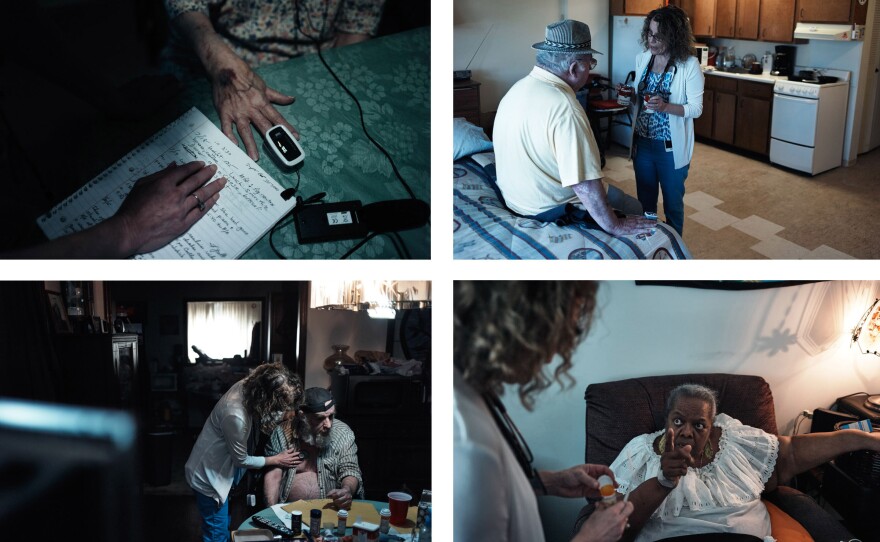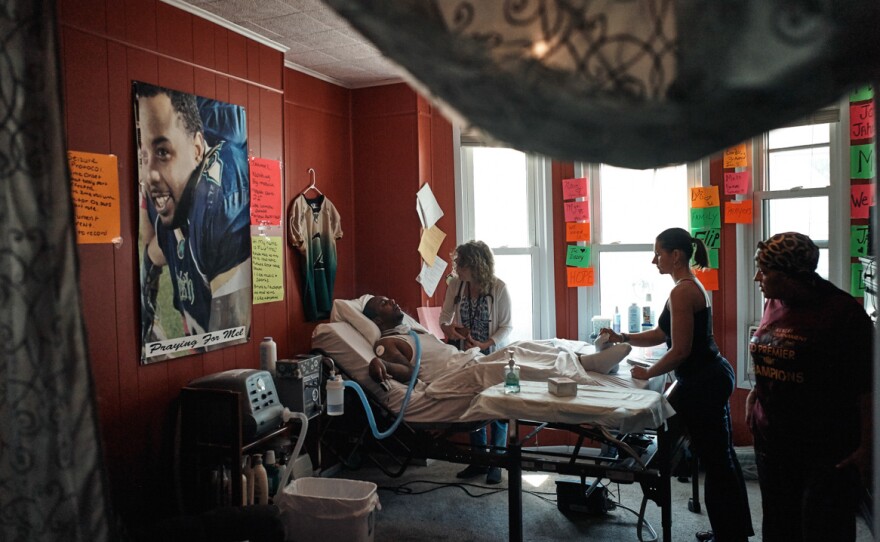Dr. Roberta Miller hits the road at 8 a.m. to see her patients.
Many are too old or sick to go to the doctor. So the doctor comes to them.
She's put 250,000 miles on her Honda minivan going to their homes in upstate New York. Home visits make a different kind of care possible.
"You can evaluate the person as a whole," says Miller, who has been a home care physician in Schenectady, N.Y., for more than 20 years. "You see everything that influences their health and well-being: the environment, the surrounding people, the support system, whether they had or didn't have food."
Miller spends about an hour at each house call. Conversation with patients and their family members flows so naturally that it's easy to miss that she's also checking vital signs, gently stretching a hand, noting which pill bottles are empty.

Although Miller's practice may harken back to the country doctor of decades past, it could be the future of medicine. In 2013, about 2.6 million Medicare claims were filed for patient home visits and house calls. That's up from 2.3 million visits in 2009 and 1.4 million visits in 1999, according to Medicare statistics.
The trend is expected to accelerate as baby boomers grow older. One in 20 people over the age of 65 is homebound in the U.S., according to a study published in July in JAMA Internal Medicine.
"That's just the nature of the population we treat," Miller says. "They're extremely ill. Homebound patients often have up to 12 or 13 problems, not just one."
And they're often invisible. These people could be living just down the block, and you'd never know it. Many of them never leave their homes.


Miller's patients include a 55-year-old woman with ALS who can communicate only with her eyes, a 27-year-old former quarterback left quadriplegic and in a coma after surgery on an Achilles tendon, a 92-year-old woman cared for by her daughter, and a severely depressed man who lives alone.

It's challenging to visit one patient after another, many of whom are at the end of the line, Miller says. What helps keep her going is the deep relationships that develop, where she acts as family, friend and physician.
"Many times, like this gentleman, he's all alone. You are it — you are the contact. And in that sense, sometimes it's overwhelming," Miller says after visiting a patient who has no family nearby. "You have to set limits, and when you do that, you can have a really excellent working relationship with people."
Being on-call for her patients 24/7 can be a challenge, but Miller feels responsible, knowing there are so few home care doctors out there. She and her husband, Dr. David Hornick, who's also a home care physician, have close to 300 patients right now. There's a long waiting list for care.
There aren't enough home care doctors to go around. One reason is reimbursement. "Health care systems are attracting primary care providers to their networks by salary packages that can't currently be sustained in a home care practice," Miller explains.


Home care skills are rarely taught in today's medical education system, Miller says, but that doesn't mean there's not a need.
After the Affordable Care Act took effect in 2014, Miller saw a spike in new patient requests. Low-income Medicaid patients had sought house calls in the past, but the government insurance wasn't enough to cover the cost of Miller's visits, including travel expenses.
"Now we can afford to see them and take care of them. Because they haven't had medical care, they have multiple medical needs and psychosocial needs," she says. "It has given us access to a group of people, but more importantly, they have access to us."
The Affordable Care Act affected Medicare patient coverage, too, Miller says. Medicare reimbursements increased in 2014 for people who are disabled or 65 and older. But reimbursements declined in 2015 because of sequestration. And now Medicaid reimbursements rates are starting to decrease as well.
Miller believes the shortage of physicians who are willing to make home visits is directly attributable to this inadequate payment for service.
"The big question is: Is there ever going to be a system where home health care providers can be reimbursed appropriately so that we can create a greater workforce of home care providers?"
She sure hopes so.
Photographer Misha Friedman says he tries "looking beyond the facts, searching for causes, and asking complex and difficult questions." His work has been featured by many media organizations, including NPR, The New Yorker, Sports Illustrated, Der Spiegel and GQ.
Freelance writer Nadia Whitehead contributed to this report.
Copyright 2023 NPR. To see more, visit https://www.npr.org. 9(MDAzMjM2NDYzMDEyMzc1Njk5NjAxNzY3OQ001))






